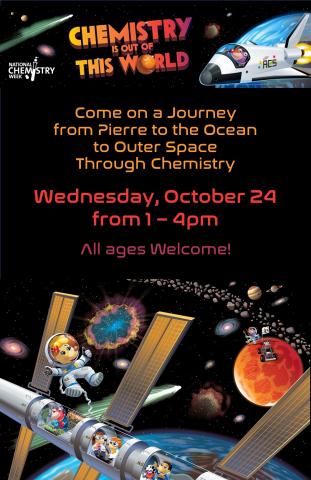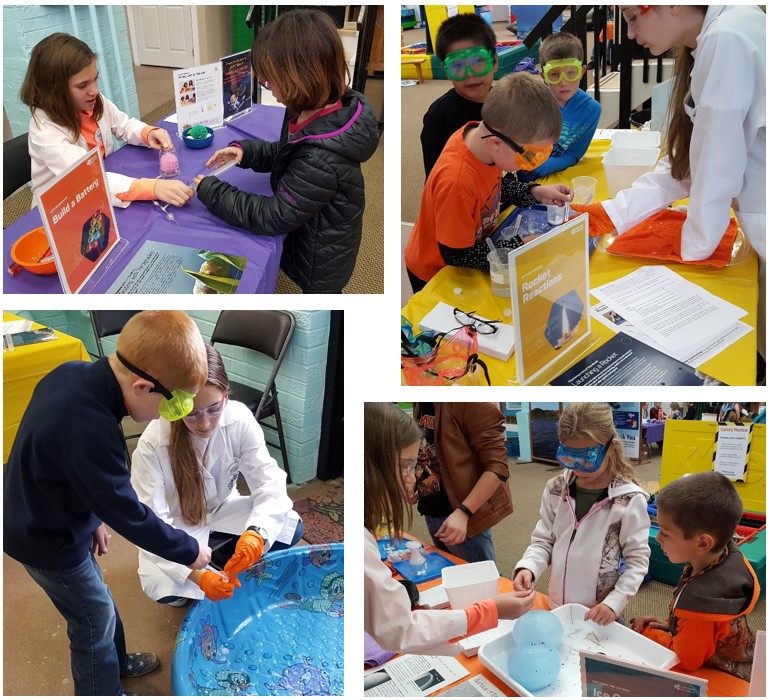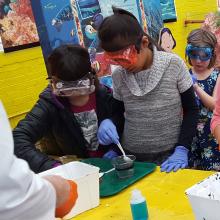What does Central South Dakota have to do with the Ocean and Outer Space? Knowing how everything is connected is essential to understand our changing world, and so is empowering kids to realize everyone can make an impact – no matter where you come from.
At the SD Discovery Center in Pierre, South Dakota, we took advantage of an early release day in our school district and took 240 visitors on a journey from Pierre to the ocean to outer space to explore connections through chemistry.
Everything came together perfectly: we had a new traveling exhibit up and running about ocean acidification “Climate Change Oceans: Acid vs. Life”, the fall early release day coincided with National Chemistry week and we had just received our NISE Network Explore Science: Let’s Do Chemistry kit. Now we just had to connect the dots.
The Missouri river runs along our museum and through our sister communities of Pierre and Fort Pierre, which makes watershed education a natural part of our outreach. For this event, we took our scope a bit further and talked about the impact we have on the ocean: why are the oceans rising and what can we do about it (Rising Sea)? How do we solve pollution and help the ocean and its inhabitants (Cleaning Oil Spills with Chemistry)? We invited our visitors to join our group of middle school volunteers called the Acid Avengers to find out how the water becomes acidic and how this effects life in the ocean (What’s in the Water, Climate Change Oceans, Acid vs. Life: Ocean in a Cup & Ocean Acidification). We prepared our voyage into space: what do you need to get ready to launch? Why you need a space suit (Molecules in Motion)? What are green energy sources to launch your rocket (Build a Battery & Rocket Reactions)? Once in space, we investigated what happens at -455° Fahrenheit (Sublimation Bubbles & Ice Orbs) and explored other planets that may be suitable for us or other life forms (Objects in Motion & Imagining Life).
With so many activities planned, we relied heavily on volunteers to lead the activities and we all know the facilitator has a big impact on the success and fun factor of the activity. We always draw upon our existing pool of volunteers, but until the day before the event we were still short on volunteers. Luckily, our leadership class at our local High School sent helpers for extra credit. Admittedly, having to rely on new volunteers that have never helped out before and the rest of our volunteers being fairly young, I was a little nervous on the day of the event. When the volunteers arrived, I gave them a quick rundown of the activity and referred them to the facilitation guides provided with the NISE Net's Explore Science: Let’s Do Chemistry kit for additional tips and background information. It was such a joy to see that not only did they all sit down and read through the material, they also went from station to station as a group, leading each other through the activities, learning together, and having fun. The activity guides were an amazing help for me and perfect to prepare my volunteers. They did an amazing job leading the activities, guiding the visitors in their explorations, giving background information and handling the mess. I was extremely impressed and proud of our volunteers and our visitors had a fantastic time!
The Explore Science: Let’s Do Chemistry kit worked perfectly in addition to the Explore Science: Earth and Space toolkits from previous years and we are excited to expand our hands-on activity collection to include chemistry! With this event we were able to provide a new experience and learning opportunity for our community, that allowed for friendly explorations and discussions of controversial topics and misconceptions. Particularly in rural areas such as Central South Dakota, Science Centers and events like these are key to education in informal settings, allowing visitors to make discoveries at their own pace and keeping an open mind.



